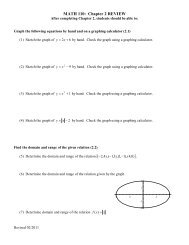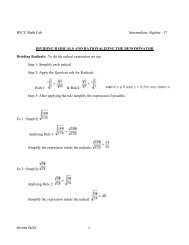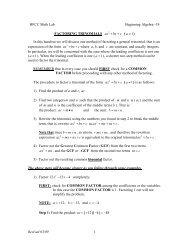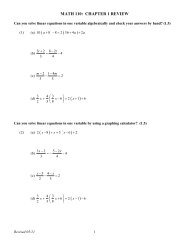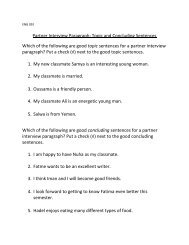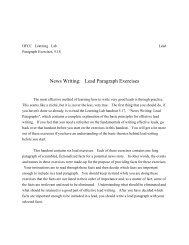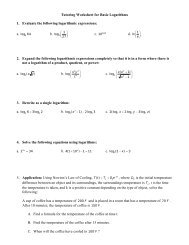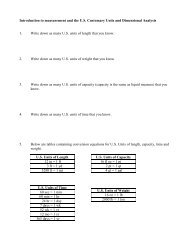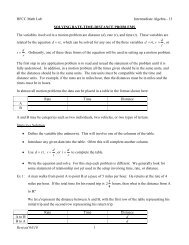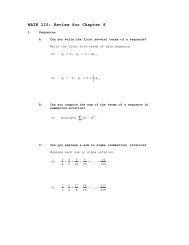What Are Inferences? - The Learning Lab at HFCC
What Are Inferences? - The Learning Lab at HFCC
What Are Inferences? - The Learning Lab at HFCC
Create successful ePaper yourself
Turn your PDF publications into a flip-book with our unique Google optimized e-Paper software.
<strong>HFCC</strong> <strong>Learning</strong> <strong>Lab</strong> Comprehension B5.3Drawing <strong>Inferences</strong>MAKING INFERENCES (BEGINNING LEVEL)You have been drawing inferences all your life. You began to make many kinds ofinferences when you were a baby. You have been getting better <strong>at</strong> the skill all the time.Yet, many students panic when they are asked to draw inferences on a reading test. <strong>The</strong>ydon't know how to go about the task. This handout will show you how to draw inferencesfrom wh<strong>at</strong> you read.<strong>Wh<strong>at</strong></strong> <strong>Are</strong> <strong>Inferences</strong>?When did you first learn to draw inferences? You learned long ago-even before you canremember. Your first inferences were probably about food. When you saw an adult comingtoward you with a jar of baby food, you knew it was time to e<strong>at</strong>. No words had to bespoken. You knew you were hungry. You recognized the jar and the label and thought,"Dinner!" You had learned how to draw the right inference.Today, you use this skill on many occasions. If you see smoke, you may infer th<strong>at</strong> there isa fire. If you hear an ambulance siren wailing on the highway, you may infer th<strong>at</strong> there hasbeen an accident. If you see a black cloud approaching from the west, you may infer th<strong>at</strong>there will be a storm. You don't think about the process each time. You don't say, "Wow!I'm drawing an inference!" But th<strong>at</strong>'s wh<strong>at</strong> you're doing.An INFERENCE is a conclusion reached WITHOUT A DIRECT STATEMENT OREXPLANATlON. If your friend says, "<strong>The</strong> Red Sox lost 11-2 last night," she has made adirect st<strong>at</strong>ement. But suppose th<strong>at</strong>, r<strong>at</strong>her than making a direct st<strong>at</strong>ement, she says,"Those poor Red Sox. Weak pitching. Three errors. Will they ever start winning again?"You may INFER th<strong>at</strong> the Red Sox lost last night, even though she hasn't said it.<strong>Inferences</strong> need to be checked for accuracy. For example, the wailing ambulance siren on thehighway may not mean an accident. <strong>The</strong> ambulance might be answering a false alarm. Orperhaps someone who is ill is being rushed to a hospital. All you can do is try to draw correct,accur<strong>at</strong>e inferences and then check them l<strong>at</strong>er if you can.Strong and Weak <strong>Inferences</strong><strong>Inferences</strong> can be either strong or weak. Let's look <strong>at</strong> both kinds.1. St<strong>at</strong>ement: When the game was over, the home fans loudly cheered theplayers.Inference:<strong>The</strong> home team won.2. St<strong>at</strong>ement: Joe didn't arrive <strong>at</strong> our house on time.Inference: Joe dislikes our family.B5.3 1
One of these inferences is more likely to be accur<strong>at</strong>e than the other. <strong>The</strong> first is a STRONGINFERENCE. Since the home fans are happy, their team probably won. You cannot becompletely sure until you check further. However, the inference seems to be a sound one.<strong>The</strong> second is a WEAK INFERENCE. <strong>The</strong>re may be many reasons for Joe's l<strong>at</strong>eness. Hemay have been caught in traffic. He may have gotten the time wrong. He may havestopped to buy a present for the family. He may be forgetful. All of these are possibilities.Joe may like the family very much, but he may still be l<strong>at</strong>e in arriving.EXERCISE IDirections:Distinguishing Between Strong and Weak inferencesClassify each of the following inferences by writing A for strong or B for weakon the line <strong>at</strong> the right.1. St<strong>at</strong>ement: <strong>The</strong> pot<strong>at</strong>oes taste burnt.Inference:<strong>The</strong>y were cooked too long or <strong>at</strong> toohigh <strong>at</strong> he<strong>at</strong>.1.________2. St<strong>at</strong>ement: Beth isn't going out for girls' basketball.Inference: She's afraid of not making the team. 2.________3. St<strong>at</strong>ement: All the lights in our neighborhood went out<strong>at</strong> once.Inference:<strong>The</strong>re's a general outage or loss ofelectrical power.3._______4. St<strong>at</strong>ement: <strong>The</strong> newspaper wasn=t deliveredto our doorstep this morning.Inference:<strong>The</strong> workers <strong>at</strong> the newspaperare on strike.4._______5. St<strong>at</strong>ement: He failed the spelling test.Inference:He didn=t study the words to betested .5._______6. St<strong>at</strong>ement: He failed the spelling test.Inference:He had bad luck because of walkingunder a ladder.6._______7. St<strong>at</strong>ement It=s 3:00 A.M., and the factory seemsclosed.Inference:<strong>The</strong> factory doesn=t oper<strong>at</strong>e 24 hoursa day.7._______B5.3 2
8. St<strong>at</strong>ement: This is the fifth time I=ve gotten poisonivy after picking blueberries in the woods.Inference: <strong>The</strong>re must be poison ivy in the woods. 8.________9. St<strong>at</strong>ement: I can=t find my science textbook.Inference: It was stolen on the bus. 9.________10. St<strong>at</strong>ement: Marie isn=t coming to the dance.Inference: She has no friends <strong>at</strong> school. 10._______Choosing the Strongest InferenceYou have now worked with strong and weak inferences. Sometimes on a test, you will beasked to pick out the STRONGEST of a number of inferences. You can use clues fromyour reading to make this choice.<strong>The</strong> following type of slot-completion passage is called a cloze exercise. In the blankspace, write the letter of the phrase th<strong>at</strong> makes the best sense in the paragraph's context.<strong>The</strong>re were no cars in the parking lot. <strong>The</strong> restaurant shades were drawn.An automobile with two couples drove into the parking area, paused a moment,and then______________________.(a)(b)(c)(d)(e)put on the lights.honked the horn.dropped off three passengers.drove off.blocked the restaurant door.Answer<strong>The</strong> people in the car probably intended to e<strong>at</strong> <strong>at</strong> the restaurant. When they got to theparking lot, they found no cars there. <strong>The</strong>n they saw th<strong>at</strong> the shades were drawn. <strong>The</strong>yinferred th<strong>at</strong> the restaurant was closed. You can probably infer th<strong>at</strong> they left. <strong>The</strong> bestanswer is (d) drove off.Inferring a Single WordSome tests ask you to choose a single word to fill a blank. Study the example. In the blankspace, write the letter of the word th<strong>at</strong> makes the best sense in the passage’s context.When Brenda returned from the long hike, her steps were slow, and her shouldersdrooped. It was clear th<strong>at</strong> she was________ from her experience.a) happy b) weary c) bright d) bitter e) boredB5.3 3
Answer<strong>The</strong>re are three main clues here: the long hike, Brenda’s slow steps, and her droopingshoulders. <strong>Wh<strong>at</strong></strong> do these clues, taken together, tell you? Let’s look <strong>at</strong> the fivepossibilities. It’s true th<strong>at</strong> under certain circumstances, any one of the answers could fit.But you are asked to infer the best answer.<strong>The</strong> answers (a) happy and (c) bright seem completely out of place. <strong>The</strong> words are toocheerful to fit Brenda’s appearance. On the other hand, (d) bitter and (e) bored, while lesscheerful, don’t fit either. Both suggest wh<strong>at</strong> Brenda’s feelings were, but there is nothing inthe two sentences about feelings or emotions. You don’t know wh<strong>at</strong> Brenda’s feelingswere-and you can’t read into the sentences more than is suggested. From wh<strong>at</strong> is written,you can only infer th<strong>at</strong> Brenda was tired. <strong>The</strong>refore, the best answer is (b) weary.Exercise II. Drawing <strong>Inferences</strong>Directions:In the blank space, write the letter of the correct answer for eachnumbered item.1. A trademark is a name, a sign, or a picture th<strong>at</strong> appears on a product to make iteasy for a customer to ______ the product.a) Overlook b) sell c) remember d) carry e) e<strong>at</strong>2. Spring rains and melting snow had made the country roads difficult to drive on; therewas ______ everywhere.a) Grass b) advertising c) ice d) sleet e) mud3. When Marilyn got on the scale, shook her head, and said, “Oh, no!” I could tell th<strong>at</strong>she was ______.a) Delighted b) afraid c) unkind d) thoughtful e) disappointed4. Since Julie has been given a surprise party every year for the past three years, wethink she ________ one this year.a) Expects b) forgets c) dislike d) enjoys e) prepares5. Traffic is so heavy on Route 52 th<strong>at</strong> the county has decided to ______ the road.a) Widen b) close c) pave d) renumber e) narrowB5.3 4
AnswersExercise I1. A Strong <strong>The</strong>se are good reasons for pot<strong>at</strong>oes tasting burnt.2. B Weak Beth may have other reasons: lack of time, family responsibilities,desire for another activity.3. A Strong Since all the lights have gone out, there is probably a generaloutage.4. B Weak <strong>The</strong>re are many possible reasons for not getting the paper: thedelivery person didn=t get up in time; the delivery person quit; thepapers didn=t reach the delivery person.5. A Strong Failing to study is a common cause for failing a test.6. B Weak <strong>The</strong>re is no connection between failing a test and walking under a lladder.7. A Strong If the factory is closed <strong>at</strong> 3:00 A.M., it seems clear th<strong>at</strong> it does notoper<strong>at</strong>e around the clock.8. A Strong Getting poison ivy five times in a row strongly suggests th<strong>at</strong> there ispoison ivy in the woods.9. B Weak <strong>The</strong>re are many other possible explan<strong>at</strong>ions: the person was careless,left the book <strong>at</strong> home or <strong>at</strong> school, or loaned it to someone else.10. B Weak Maria may not be coming because she is ill, has something elseplanned, doesn=t like dancing, or has other reasons.B5.3 5



